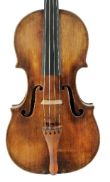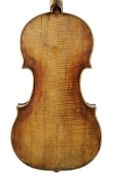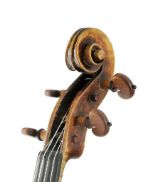Violin, Michelangelo Bergonzi, Cremona, around 1740
Printed label with a decorative border: “Michel Angelo Bergonzi / Figlio di Carlo fece / Cremona l’Anno 17..” (the last two numerals are handwritten and illegible)No records show with whom Michelangelo Bergonzi apprenticed, but there is every reason to assume that his father, Carlo, taught him the violinmaking craft. Shortly after Michelangelo got married in 1745, the young couple and Michelangelo’s father moved into the Casa Stradivari. Hence, the young luthier had access to all the materials, tools and, above all, the wealth of experience accumulated by the masters of the classical Cremonese violinmaking school. After Carlo’s death in 1747, Michelangelo was the last of the great Cremonese violinmakers.
The violin was made in the 1740s and is built on a large, quite independent model with flat arching. The C-bouts are very wide open, and the corners are short. The medium-wide annual rings of the two-part belly are very regularly structured. A dendrochronological report established that the youngest annual ring of the belly was dated as early as 1719. The two halves of the belly are symmetrically structured, with the wood probably taken from the same log. The dendrochronological findings show a very high correlation with two instruments by Carlo Bergonzi as well as with instruments from Antonio Stradivari’s late period. This confirms that Michelangelo Bergonzi was able to source his wood from the same stock as the best luthiers of the preceding generation. The violin’s divided, quarter-cut back displays very tight, horizontal flaming. A small knot is located in the upper part of the treble side. The very high ribs show faint but narrow flames. The shape of the f-holes is unconventional: They are slanted and very wide open. The delicate edgework contrasts with a broad purfling. The powerful-looking scroll is typical of the Cremonese tradition. The bass-side volute is somewhat lower than its counterpart on the treble side. The structure of the volutes is reminiscent of the work of Michelangelo’s father, Carlo, but the eyes are much shorter. The golden-yellow ground is coated with an orange-red to light brown color varnish, visible above all on the back plate and the ribs.





